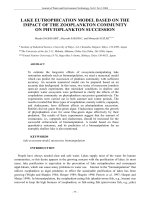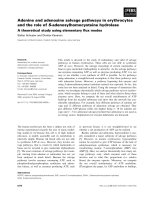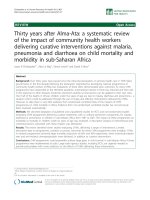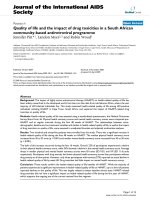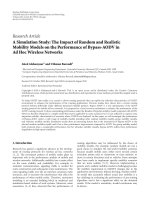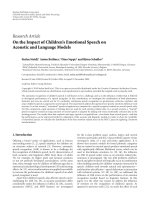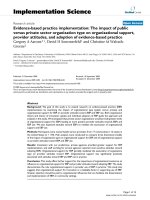The impact of hospital-based and community based models of cerebral palsy rehabilitation: A quasi-experimental study
Bạn đang xem bản rút gọn của tài liệu. Xem và tải ngay bản đầy đủ của tài liệu tại đây (842.14 KB, 10 trang )
Dambi and Jelsma BMC Pediatrics 2014, 14:301
/>
RESEARCH ARTICLE
Open Access
The impact of hospital-based and community
based models of cerebral palsy rehabilitation:
a quasi-experimental study
Jermaine M Dambi1* and Jennifer Jelsma2
Abstract
Background: Cerebral palsy requires appropriate on-going rehabilitation intervention which should effectively meet
the needs of both children and parents/care-givers. The provision of effective support is a challenge, particularly in
resource constrained settings. A quasi-experimental pragmatic research design was used to compare the impact of
two models of rehabilitation service delivery currently offered in Harare, Zimbabwe, an outreach-based programme
and the other institution-based.
Method: Questionnaires were distributed to 46 caregivers of children with cerebral palsy at baseline and after three
months. Twenty children received rehabilitation services in a community setting and 26 received services as outpatients
at a central hospital. The Gross Motor Function Measurement was used to assess functional change. The burden of care
was measured using the Caregiver Strain Index, satisfaction with physiotherapy was assessed using the modified
Medrisk satisfaction with physiotherapy services questionnaire and compliance was measured as the proportion
met of the scheduled appointments.
Results: Children receiving outreach-based treatment were significantly older than children in the institution-based
group. Regression analysis revealed that, once age and level of severity were controlled for, children in the
outreach-based treatment group improved their motor function 6% more than children receiving institution-based
services.
There were no differences detected between the groups with regard to caregiver well-being and 51% of the
caregivers reported signs consistent with clinical distress/depression. Most caregivers (83%) expressed that they
were overwhelmed by the caregiving role and this increased with the chronicity of care. The financial burden of
caregiver was predictive of caregiver strain.
Caregivers in the outreach-based group reported greater satisfaction with services and were more compliant
(p < .001) as compared to recipients of institution-based services.
Conclusion: Long term caregiving leads to strain in caregivers and there is a need to design interventions to alleviate
the burden. The study was a pragmatic, quasi-experimental study thus causality cannot be inferred. However findings
from this study suggest that the provision of care within a community setting as part of a well-structured outreach
programme may be preferable method of service delivery within a resource-constrained context. It was associated with
a greater improvement in functioning, greater satisfaction with services and better compliance.
Keywords: Cerebral palsy, Community based rehabilitation, Institution based intervention, Rehabilitation, Zimbabwe
* Correspondence:
1
Research Fellow at University of Cape Town, Lecturer Department of
Rehabilitation, College of Health Sciences, University of Zimbabwe, PO Box
AV 178, Avondale, Harare, Zimbabwe
Full list of author information is available at the end of the article
© 2014 Dambi and Jelsma; licensee BioMed Central Ltd. This is an Open Access article distributed under the terms of the
Creative Commons Attribution License ( which permits unrestricted use,
distribution, and reproduction in any medium, provided the original work is properly credited. The Creative Commons Public
Domain Dedication waiver ( applies to the data made available in this
article, unless otherwise stated.
Dambi and Jelsma BMC Pediatrics 2014, 14:301
/>
Background
Cerebral palsy (CP) is the most common paediatric
neurological condition [1] and the principal cause of
disability in children globally [2]. It is defined as “a group
of disorders of the development of movement and posture,
causing activity limitation, that are attributed to nonprogressive disturbances that occurred in the developing
fetal or infant brain. The motor disorders of cerebral palsy
are often accompanied by disturbances of sensation,
cognition, communication, perception, and/or behaviour,
and/or by a seizure disorder” [3]. CP is a universal problem [2] with a global incidence of 2 to 3 cases per 1 000
births [4]. The exact prevalence in Zimbabwe is unknown:
however, from extrapolated data, the incidence is similar
and estimated at 1.55/1000 in rural areas and 3.3/1000 in
urban areas [5].
Children with CP face multiple bio-psychosocial challenges [6,7]. This coupled to the fact that CP is a lifetime
condition [2,3,8], may result in a considerable burden on
caregivers of children with severe impairments, affecting
their health and health related quality of life [9,10].
Rehabilitation treatment is an essential component
[1,11] of the multi-disciplinary approach required to
address the problems of children with CP and their
families [8,12]. Researchers have not yet identified the
most effective method of service delivery in terms of
optimising the child’s potential and providing support
to the caregiver, especially in low-income countries
such as Zimbabwe. Issues such as accessibility and
acceptability of services, compliance with training and
efficacy of the intervention need to be considered
when implementing any model of service delivery.
Different models of rehabilitation service delivery have
been proposed in an attempt to provide affordable and
appropriate support to people living with disabilities and
these can be broadly classified as either institution–based
(IB) or community based rehabilitation (CBR)/outreachbased (OR) approaches [13,14]. The roots of CBR can be
traced back to the Declaration of Alma-Atta which led to
the adoption of the global primary health care strategy
by the World Health Organization (WHO). The aim of
CBR was to provide primary health care and rehabilitation services to people with disabilities within their
communities [15]. CBR has been in existence for more
than 3 decades [15-18] yet little is known about its
efficacy, effectiveness, relevance, appropriateness and
sustainability as a service delivery model and public
health strategy [19-21].
Zimbabwe utilizes a hybrid model of provision of
rehabilitation services that is a blend of hospital-based
and community-based approaches which are provided
at district, provincial and central hospitals [22]. Unfortunately, a decade of socio-economic meltdown has
resulted in deterioration of the health care delivery
Page 2 of 10
system [23]. At present, organization of rehabilitation
services varies from institution to institution and is
mainly governed by resource availability. Most institutions are now offering hospital-based services only.
For instance, out of the six state central hospitals in
Zimbabwe, only Harare Central Hospital (HCH) is at
present running a consistent outreach program through its
Children Rehabilitation Unit (CRU) [22]. The CRU is a
specialized paediatric rehabilitation centre, which, for more
than twenty years, has run a peri-urban, community-based
outreach programme based on the WHO CBR model.
Children and their care-givers (mostly mothers) gather
in groups twice a month in community centres. Children
receive some individual treatment from therapists and/or
rehabilitation technicians (who have undergone two years
of training). In addition, there are group activities and
education sessions. In contrast, children in another
high-density area of Harare, which is serviced by a
different hospital, receive regular physiotherapy within
an institutional out-patient setting. As the outreach
programme relies on a certain amount of donor funding,
it is somewhat more expensive to run [22].
There was a clear need to compare the two models
of service delivery, not only to inform the on-going
re-structuring of rehabilitation services in Zimbabwe
[23], but to provide empirical evidence of the relative impact
of CBR/outreach services as compared to institutionallybased rehabilitation [11].
The objectives of the study were therefore to compare the impact of the outreach (OR) and the institutionally based (IB) programs in terms of their impact
on the children’s functioning, the strain on their caregivers, compliance with scheduled appointments and
the overall satisfaction with the services received. It
was anticipated that there would be little difference in
the functional change between the two groups. The
greater group interaction and support were expected to
result in a greater decrease in the strain of the care-givers
attending the outreach group. The satisfaction with
services was expected to be greater in the outreach
group as the service was brought to them and they did
not need to travel far to get support for their children.
Methods
A quasi-experimental design was used as it was a pragmatic trial and it was not possible to randomly assign
children to one group or the other. The geographical
location determines a child’s program allocation as the
two areas are some distance apart, children and caregivers
were thus obliged to attend one or other programme
depending on their place of residence. A sample of convenience was drawn from the children treated under the
OR program and IB CP clinics who attended the clinics
during the first four weeks of the study.
Dambi and Jelsma BMC Pediatrics 2014, 14:301
/>
The children had to have received a diagnosis of CP
according to their patient notes. They were to be between
0.5 to 12 years of age as the Gross Motor Function
Measure (GMFM) has good content and face validity for
children in the age range 0.5 to 13 years [24] and the discharge age for the CRU Outreach program is 12 years. No
participant was recruited if they were scheduled for surgery
or if they had any other significant medical and nutritional
problems or other clinical factors that might have biased
the rehabilitation program [25,26]. Children who had comorbid neurological conditions e.g. Spinal Bifida or who
were receiving other forms of therapeutic interventions
such as private physiotherapy were similarly excluded.
The burden of care as measured by the Caregiver
Strain Index (CSI) [27] was one of the major variables
under scrutiny. Assuming mean CSI scores of 7 and 9
(SD = 2) for both groups [28] at the conclusion of the
study period, the expected minimal number of cases per
group was 16 (alpha = .05, power = 95%). Oversampling
was done to counteract effects of attrition due to e.g.
sickness and non-compliance.
Instrumentation
The Gross Motor Function Measure −66 item version
(GMFM-66) is a condition specific and widely used,
standardized and validated ordinal scale which measures
changes in motor function in children with CP [24,29,30].
Functional prognosis is dependent on level of severity
and this we measured using the Gross Motor Function
Classification System (GMFCS) which is a valid and
reliable tool [24,31]. This classifies severity on a 5-level
ordinal scale, with children in level one being least
affected and level five being more severely affected and
functionally dependent [31]. The Caregiver Strain Index
[32] and Medrisk Instrument for Measuring Patient
Satisfaction with Physical Therapy Care (MRPS), [33]
have been reported to be valid and reliable tools in
measuring the burden of care and satisfaction with
services respectively [27,33]. The tools were translated
into the native language, Shona, using a backwardforward approach. The tools were then validated on a
group of caregivers, n = 20 of children with CP receiving outpatient services at CRU who were not part of
the main study. The caregivers completed the questionnaires and were requested to give comments on the
appropriateness, validity and clarity of the tools. After
feedback, the tools were re-administered after a week in
order to assess the internal consistency (Cronbach’s
alpha = .78), validity and reliability (r = .82) of the tools,
all of which were found to be acceptable.
Intervention
The children and parents (mostly mothers) in the OR
arm gathered in groups twice a month in community
Page 3 of 10
centres. In the IB arm, the frequency of appointments
was variable and was dependent on the discretion of the
treating therapists. In both arms, children received some
individual face to face treatment from therapists. In
addition, the OR arm received group activities, where
caregivers were requested to demonstrate home exercise
programs to other caregivers as well as sharing the challenges and achievements of caregiving. Additionally, the
OR arm received educational sessions on the aetiology,
management of CP and ways of coping with the associated
burden of care. They were provided with light refreshment
after therapy sessions and were given the option to participate in caregiver support group activities such as
joint income generation projects. The OR programme
receives donor funding and employs more rehabilitation
professionals which improves the therapist/child ratio.
In addition, allowances paid to professionals for every
outreach outing makes it more expensive to run [22].
Procedure
A pilot study was done to determine the intra-rater reliability of the GMFCS and GMFM-66 scoring as well as refining data collection procedures (see above). Caregivers were
then recruited by the research team over four consecutive
weeks. Caregivers were approached as they were awaiting
services or after their children were treated. Once informed
consent had been obtained, CSI questionnaires were distributed to caregivers which were self-administered. The
principal researcher then documented the motor function
scores of children with CP using the GMFM-66 and the
GMFCS. It would have been difficult to transport participants to a neutral venue so all assessments were done at
usual treatment settings and the usual treatment days
to avoid inconveniencing the caregivers. Consequently
blinding to group membership was not possible. The
compliance with scheduled appointments was captured
throughout the study. Twelve weeks later, the same procedure was followed in scoring the CSI, GMFM-66
scores and additionally the modified MRPS questionnaire was applied. Both groups were provided with
snacks and drinks after data collection procedures.
Ethical considerations
Ethical approval was granted by the University of Cape
Town (ref 109/2012) and the Medical Research Council
of Zimbabwe (MRCZ/B/333). Consent was sought from
caregivers, rehabilitation professionals and verbal assent
was requested from children who could communicate
(n = 5). Fifteen caregivers refused consent. Caregivers
were assigned identity numbers to preserve confidentiality and only the principal researcher had access to the
collected raw data which was kept in a safe locker. Both
groups of participants were treated equally to achieve
social justice.
Dambi and Jelsma BMC Pediatrics 2014, 14:301
/>
Data analysis
Statistical analysis was performed using STATISTICA
version 10. We used an alpha level of 0.05 for all statistical tests. Analysis was per protocol. As most of the data
were non-parametric, the Mann–Whitney U, chi-squared
and Fishers’ Exact tests were used to compare results
between the two groups in terms of the difference in
demographics, MRPS and CSI. The scores on the GMFM66 were transformed into interval data using the Gross
Motor Ability Estimator (GMAE-2) Scoring Software
for the GMFM [34] which is a software package for
scoring the Gross Motor Function Measure (GMFM)
based on item response theory. A one way ANOVA was
used to compute differences in GMFM-66 and CSI
scores at different times.
As age was significantly different between the two
groups and there were more severely affected children in
the community based treatment group, regression analysis
Page 4 of 10
was done to establish which factors predicted the amount
of change in the GMFM Score. Dummy variables were
created for the categorical variable of the group and the
ordinal variable of GMFCS was dichotomised into levels
mild/moderate (I, II and III) and severe (IV and V).
Residual analysis was performed and children who had
residual scores of more than 2.5 SD from the mean were
excluded.
Results
Demographic and medical characteristics
A total of 107 potential participants were approached
for recruitment into the study, of these, 42 were from
OR and 65 from IB. As can be seen in Figure 1, 32 did
not meet the inclusion criteria or declined participation
(15). A further four in the OR group and 11 in the IB were
lost to follow-up for different reasons. Ultimately 20 in the
OR and 26 children in the IB groups completed the study.
Figure 1 Flow chart of the study. 107 potential participants were approached, of which 28 did not meet the inclusion criterion. Of these, 15 were
lost to follow up given a final sample size of 46 for data analysis.
Dambi and Jelsma BMC Pediatrics 2014, 14:301
/>
Page 5 of 10
Demographic information on the 46 dyads of caregiver
and child with CP who participated are presented in
Table 1. Children receiving IB treatment were significantly younger than those in the OR group, (12 as
opposed to 44 months). However, the two groups were
comparable in terms of the socio-demographics of both
children and caregivers at baseline. In the IB group 38%
of the children were in the most severe levels of the
GMFCS, compared to 50% in the OR group, however
the proportions in each level were not significantly associated with group.
Treatment sessions and compliance
The therapist hour’s ratio was calculated by dividing the
product of number of therapists and total number hours
of therapy provided by total number of children treated
over the study period. As can be seen in Table 2, they
were no statistically significant differences in terms of
the organization of treatment sessions, χ2 = 0.711, df = 1,
p = 0.399 and children in the OR group received a
significantly higher amount of therapy time, t(43) = 3.19,
p = 0.003.
Caregivers in the OR group were expected to attend
every two weeks and in the IB group, caregivers were
given a variable number of appointments; this is illustrated in Table 3.
The percentage compliance was calculated by dividing
the number of attendances by the maximum number of
attendances possible. The mean percentage compliance was
significantly greater in the OR group: 93.3% (median = 100,
range: 67–100) for the OR group and 72.8% (median = 72.5,
range: 33–100) for the IB group, (Z = −3.56, p < .001).
Table 1 Study population demographic characteristics, N = 46
Gender
OR (n = 20)
IB (n = 26)
Total
n
n
n (%)
Statistic
p-value
Males
11
14
25 (54)
χ2 = 0.049
0.825
Females
9
44 (49)
12
21 (46)
df = 1*
12 (7)
26 (36)
U = 170.0, Z = −1.928
0.047
I
II
5
8
13(28)
U = 0.790
0.448
3
4
7 (15)
Z = 0.429
III
2
4
6 (13)
IV
2
2
4 (9)
Mean age of children in months (SD)
GMFCS Level
CP type
V
8
8
16 (35)
Spastic
16
21
37 (80)
Athetoid/dyskinetic
3
2
5 (11)
Ataxic
1
1
2 (4)
Mixed
0
2
2 (4)
33 (12)
28 (5)
30.4 (9.2)
U = 192.00, Z = 1.496
0.134
Mother
16
22
38 (83)
χ2 = .710
0.701
Grandmother
2
3
5 (11)
χ2 = 0.0
0.948
df = 3
Mean caregiver age (SD) in years
Relationship to child
df = 2
Sibling
2
1
3 (7)
Caregiver
Primary
2
2
4(9)
Educational level
Secondary
13
17
30 (65)
Tertiary
4
5
9 (20)
None
1
2
3 (7)
Unemployed
12
16
28 (61)
χ2 = 4.268
0.371
df = 3
Caregiver
χ2 = 0.802
df = 2
Employment status
*- With Yates correction of continuity.
Informally employed
7
7
14 (30)
Formally employed
1
3
4 (9)
0.67
Dambi and Jelsma BMC Pediatrics 2014, 14:301
/>
Page 6 of 10
Table 2 Treatment sessions details for the study duration
Type of treatment rendered
OR
IB
Statistic
p-value
Individual therapy sessions
3
3
χ2 = 0.711
0.399
Health promotional talks
6
3
Mean (SD)
0.29 (.07)
0.21 (.10)
Median
0.30
0.37
Range
0.20-0.40
0.27-0.54
df = 1*
Therapist hours ratio
t(43) = 3.19
0.003
*- With Yates correction of continuity.
Impact on function
The GMFM-66 scores over time (Table 4) were compared and whereas there were no between group differences detected, the improvement over time for both
groups combined was significant.
The regression model (Table 5) with the change in
GMFM-66 scores as dependent variable accounted for
about a quarter of the variance (adjusted R2 = .27) after
residual analysis resulted in the scores of two children
being removed. The results indicate that, once age and
category were controlled for, children in the OR group
improved 2.49 points more on the GMFM-66 than
children receiving IB services. This equates to approximately a 6% difference in improvement (2.49/41.5
at baseline). Children who were less severely disabled
showed 1.96 points more improvement and for each
month of age, older children showed .02 less improvement
Impact on caregivers
The majority of both groups reported an impact on
inconvenience, physical strain, confining, family adjustments; personal plans and work adjustments (Table 6).
The greatest number reported problems with financial
strain and feeling overwhelmed.
Further, the caregivers experienced a high burden of
care (Table 7) and 50% (n = 23) of the caregivers had
scores greater than or equal to seven which is the cut-off
point for clinical distress/depression [32].
The sign test indicated that there were no changes in
CSI score over the course of the study (p = 1.0). There
were also no differences in the median scores between
Table 3 Frequency of appointments for the study
duration, N = 46
Variable
Attribute
OR
IB
Met appointments
Mean (SD)
5.6 (0.7)
3.8 (2.6)
Median
6
3
Range
4-6
1-9
Mean (SD)
6 (0)
5.1 (3.1)
Median
6
5
Range
-
1-10
Scheduled appointments
the two groups or in the proportion reporting clinical
distress (score greater than seven) either at baseline
(p = .385) or three months (p = .221).
Satisfaction with services
As shown in Table 8, caregivers in the OR group reported greater satisfaction with services and statistically
significant differences were found in all domains apart
from the registration process, comfort of the waiting
area and being treated with respect.
Discussion and conclusions
The objectives of the study were to compare the impact
of the outreach (OR) and the institutionally based (IB)
programs in terms of their impact on the children’s
functioning, the strain on their caregivers, compliance
with scheduled appointments and the overall satisfaction
with the services received. It should be noted that the
“entire package”, which encompassed the location (community or institutional based), the increased training
and experience of the OR personnel, the structure of the
therapy sessions and the provision of refreshments during the OR sessions were compared. It was not possible,
using this research design, to isolate which components of the programmes resulted in the differences
seen. The results of the study indicate that in several
respects the OR programme was superior to the IB
programme. The sample appeared to be representative
of children with CP in that the majority had spastic
type CP (80%) which is the most common variant of
CP as reportedly accounts for 80–83% of cases
[11,35-37]. The spread across the different GMFCS
levels was similar to a large scale study in Canada,
which reported 42% of the children were severely affected (Levels IV and V) compared to 44% in this study
[31]. The predominance of males in the sample has
also been reported in other samples of children with
CP [6,38,39]. It would therefor appear that the children
in this study were representative of most samples of
children with CP.
A problem with quasi-experimental studies is that
there may be confounding variables that may bias the
